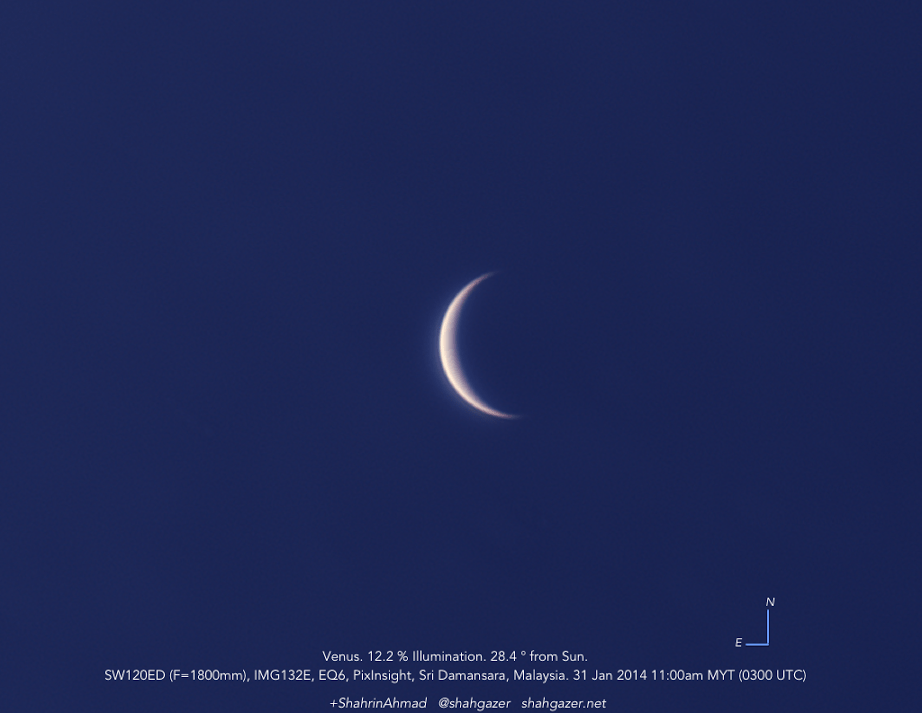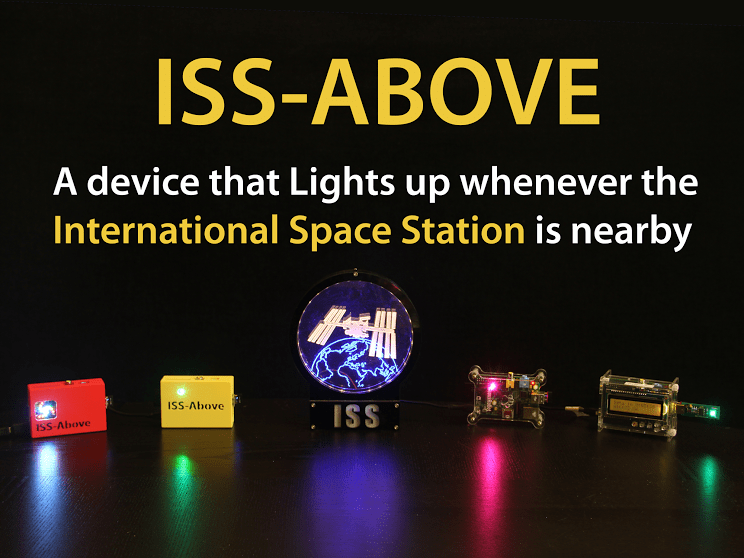Out here in the Milky Way’s suburbs, stellar collisions are unheard of. But there are places in the galaxy where stars whiz past each other, and collisions can happen. When stars collide, it’s a catastrophic event, and the stellar wreckage is visible half a galaxy away.
Continue reading “Astronomy Cast Ep. 332: Stellar Collisions”
Watch Venus as it Wanders Through the Dawn in 2014
Are you a chronic early riser? Observational astronomy often means late nights and early mornings as daylight lengths get longer for northern hemisphere residents in February through March. But this year offers another delight for the early morning crowd, as the Venus is hanging out in the dawn skies for most of 2014.
You may have already caught sight of the brilliant world: it’s hard to miss, currently shinning at a dazzling -4.5 magnitude in the dawn. Venus is the brightest planet as seen from Earth and the third brightest natural object in the night sky after the Sun and the Moon.
Venus just passed between the Earth and the Sun last month on January 11th at inferior conjunction. Passing over five degrees north of the Sun, this was a far cry from the historic 2012 transit of the solar disk, a feat that won’t be replicated again until 2117 AD.
But February and March offer some notable events worth watching out for as Venus wanders in the dawn.
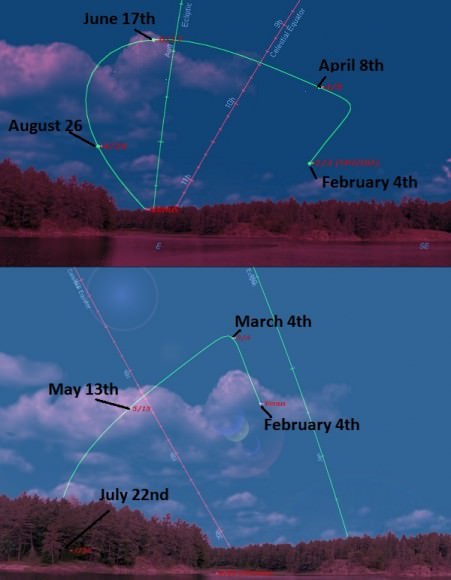
This week sees Venus thicken as a 48” 16% illuminated waxing crescent as it continues to present more of its daytime side to the Earth. We’ve always thought that it was a bit of cosmic irony that the closest planet too us presents no surface detail to observers: Venus is a cosmic tease. This assured that astronomers knew almost nothing about Venus until the dawn of the Space Age — guesses at its rotational speed and surface conditions were all widely speculative. Ideas of a vast extraterrestrial jungle or surface-spanning seas of seltzer water oceans gave way to the reality of a shrouded hellish inferno with noontime temps approaching 460 degrees Celsius. Venus is also bizarre in the fact that it rotates once every 243 Earth days, which is longer than its 224.7 day year — you could easily out walk a Venusian sunrise, that is if you could somehow survive to see it from its perpetually clouded surface!
Venus also passes 4.3 degrees from faint Pluto this week on February 5th. And while Pluto is a tough catch at over a million times fainter than Venus, it’s interesting to consider that NASA’s New Horizons and ESA’s Rosetta spacecraft are also currently off in the same general direction:

Venus also reaches greatest brilliancy at magnitude -4.6 next week on February 11th. Venus is bright enough to cast a shadow onto a high contrast background, such as freshly fallen snow. Can you see your “Venusian shadow” with the naked eye? How about photographically?
Venus then goes on to show its greatest illuminated extent to us on February 15th. This combination occurs because although the crescent of Venus is fattening, the apparent size of the disk is shrinking as the planet pulls away from us in its speedy interior orbit. Can you spy the elusive “ashen light of Venus” through a telescope? Long a controversy, this has been reported by observers as a dim “glow” on the nighttime hemisphere of Venus. Proposed explanations for the ashen light of Venus over the years have been airglow, aurorae, lightning, Venusian land clearing activity (!) or, more likely, an optical illusion.
And speaking of which, the crescent Venus gets occulted by the waning crescent Moon on February 26th. Observers in western Africa will see this occur in the predawn skies, and the rest of us will see a close pass of the pair worldwide. Can you spot Venus near the crescent Moon in the daytime sky on the 26th?
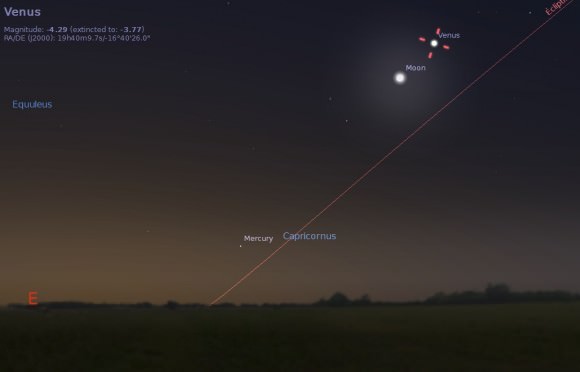
In March, Venus begins the slide southward towards the point occupied by the Sun months earlier and heads towards its greatest westward elongation for 2014 on March 22nd at 46.6 degrees west of the Sun. Interestingly, Venus is tracing out roughly the same track it took 8 years ago in 2006 and will trace again in 2022, when it will also spend a majority of the year in the dawn once again. The 8-year repeating cycle of Venus is a result of the planet completing very nearly 13 orbits of the Sun to our 8. Ancient cultures, including the Maya, Egyptians, and Babylonian astronomers all knew of this period.
Through the telescope, Venus appears at a tiny “half-moon” phase 50% illuminated at greatest elongation, a point known as dichotomy. It’s interesting to note that theoretical and observed dichotomy can actually vary by several days surrounding greatest elongation. An optical phenomenon, or a true observational occurrence? When do you judge that dichotomy occurs in 2014?
In April, one of the closest planetary conjunctions occurs of 2014 on the 12th involving Neptune and Venus at just 40’ apart, a little over the span of a Full Moon. Can you squeeze both into an eyepiece field of view? At +7.7th magnitude, Neptune shines at over 25,000 times fainter than Venus. Neith, the spurious “moon” of Venus described by 18th century astronomers lives!
But two even more dramatic conjunctions occur late in the summer, when Jupiter passes just 15’ from Venus on August 18th and Regulus stands just 42’ from Venus on September 5th. Fun fact: Venus actually occulted Regulus last century on July 7th, 1959!
From there on out, Venus heads toward superior conjunction on the far side of the Sun on October 25th, to once again emerge into the dusk sky through late 2014 and 2015.
Be sure to check out these dawn exploits of Venus through this Spring season and beyond!
Inside the Drake Equation: A Chat with Frank Drake
This interview with Frank Drake — sometimes called the Father of the Search for Extraterrestrial Intelligence – was recorded in 2012 but not released until now to celebrate the beginning of the 30th year of the SETI Institute. As interviewer Andrew Fraknoi says, “I don’t think anyone had a conversation like this that was recorded with Galileo or William Herschel or Edwin Hubble, but I get to do it with Frank Drake!”
This is a great conversation that alternates between Drake’s current work with SETI and the history of his work that led to the famous Drake Equation. Fraknoi and Drake have an interesting exchange about the value of N, which is the number of civilizations in The Milky Way Galaxy whose electromagnetic emissions would be detectable.
It was recorded in June 2012 at an event called SETICon, which featured a series of talks, panels, and events featuring scientists, authors, futurists, and film-makers.
Fraknoi is a professor of astronomy and also works with the Astronomical Society of the Pacific and they have made available a written history of Frank Drake and his equation.
Carnival of Space #339
This week’s Carnival of Space is hosted by Gadi Eidelheit at his The Venus Transit blog.
Click here to read Carnival of Space #339.
And if you’re interested in looking back, here’s an archive to all the past Carnivals of Space. If you’ve got a space-related blog, you should really join the carnival. Just email an entry to [email protected], and the next host will link to it. It will help get awareness out there about your writing, help you meet others in the space community – and community is what blogging is all about. And if you really want to help out, sign up to be a host. Send an email to the above address.
Could We Harvest Energy From a Star?
Our civilization will need more power in the future. Count on it. The ways we use power today: for lighting, transportation, food distribution and even entertainment would have sounded hilarious and far fetched to our ancestors.
As our technology improves, our demand for power will increase. I have no idea what we’ll use it for, but I guarantee we’ll want it. Perhaps we’ll clean up the oceans, reverse global warming, turn iron into gold, or any number of activities that take massive amounts of energy. Fossil fuels won’t deliver, and they come with some undesirable side effects. Nuclear fuels will only provide so much power until they run out.
We need the ultimate in energy resources. We’ll want to harness the entire power of our star. The Soviet astronomer Nikolai Kardashev predicted that a future civilization might eventually harness the power of an entire planet. He called this a Type I civilization. A Type II would harness the entire energy output of a star. And a Type III civilization would utilize the power of their entire galaxy. So let’s consider a Type II civilization.
What would it actually take to harness 100% of the energy from a star? We’d need to construct a Dyson Sphere or Cloud and collect all the solar energy that emanates from it. But could we do better? Could we extract material directly from a star?
You bet, it’s the future!
This is an idea known as “stellar lifting”. Stealing hydrogen fuel from the Sun and using it for our futuristic energy needs. In fact, the Sun’s already doing it… poorly. Stars generate powerful magnetic fields. They twist and turn across the surface of the star, and eject hydrogen into space. But it’s just a trickle of material. To truly harness the power of the Sun, we need to get at that store of hydrogen, and speed up the extraction process.
There are a few techniques that might work. You can use lasers to heat up portions of the surface, and increase the volume of the solar wind. You could use powerful magnetic fields to carry plasma away from the Sun’s poles into space.Which ever way it happens, once we’ve got all that hydrogen. How do we use it to get energy? We could combine it with oxygen and release energy via combustion, or we could use it in our space reactors and generate power from fusion.

But the most efficient way is to feed it to a black hole and extract its angular momentum. A highly advanced civilization could siphon material directly from a star and send it onto the ergosphere of a rapidly spinning pet black hole.
Here’s Dr. Mark Morris, a Professor of Astronomy at UCLA. He’ll explain:
“There is this region, called the ergosphere between the event horizon and another boundary, outside. The ergosphere is a very interesting region outside the event horizon in which a variety of interesting effects can occur. For example, if we had a black hole at our disposal, we could extract energy from spinning black holes by throwing things into the ergosphere and grabbing whatever comes out at even higher speeds.”
This is known as the Penrose process, first identified by Roger Penrose in 1969. It’s theoretically possible to retrieve 29% of the energy in a rotating black hole. Unfortunately, you also slow it down. Eventually the black hole stops spinning, and you can’t get any more energy out of it. But then it might also be possible to extract energy from Hawking radiation; the slow evaporation of black holes over eons. Of course, it’s tricky business.

Dr. Morris continues, “There’s no inherent limitation except for the various problems working in the vicinity of a massive black hole. One can’t be anywhere near a black hole that’s actively accreting matter because the high flux of energetic particles and gamma rays. So it’s a hostile environment near most realistic black holes, so let me just say that it won’t be any time soon as far as our civilization is concerned. But maybe Type III civilizations so far beyond us that it exceeds our imagination won’t have any problem.”
A Type 3 civilization would be so advanced, with such a demand for energy, they could be extracting the material from all the stars in the galaxy and feeding it directly to black holes to harvest energy. Feeding black holes to other black holes to spin them back up again.
It’s an incomprehensible feat of galactic engineering. And yet, it’s one potential outcome of our voracious demand for energy.
Confused Mercury Crater Looks Icy, But May Be Evaporation Evidence

At first glance, you’d think that white stuff on the floor of Kertesz crater is ice, especially since that substance has been confirmed on its home planet — Mercury. This new shot of the 19-mile (31-kilometer) crater in the Caloris basin shows off irregular depressions, or hollows, that jump out in this color-enhanced picture taken by NASA’s MESSENGER spacecraft. More close-up pictures from previous passes are below the jump.
“The bright material on the floor of Kertész crater is not the water ice recently confirmed to be in craters near Mercury’s poles, but it might well be behaving as ice would on another planet,” NASA wrote in 2012.
“Mercury’s daytime temperatures are so hot at most latitudes that rocks that would be stable at other places in the Solar System may essentially evaporate on Mercury. That is one theory for the formation of these bright, irregular features known as hollows seen here and in many other craters on Mercury.”
There’s still much to learn, so scientists are probably grateful that MESSENGER is still working beyond its design lifetime. It was originally supposed to conclude in 2011, but its mission was extended further to see the effects of the solar maximum on the solar system’s closest planet to the sun.
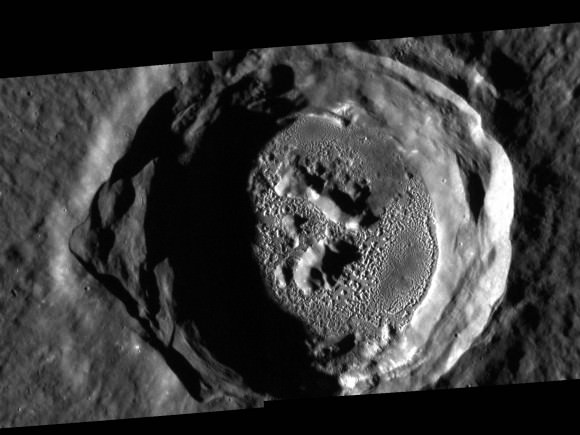

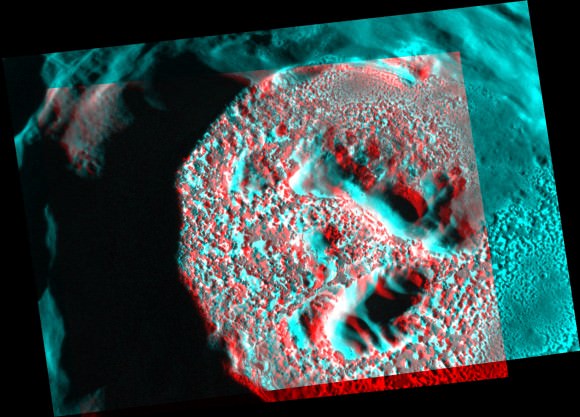
Ghostly Moon Crowns Pictures Beamed To Earth In Astronaut’s Twitter Feed
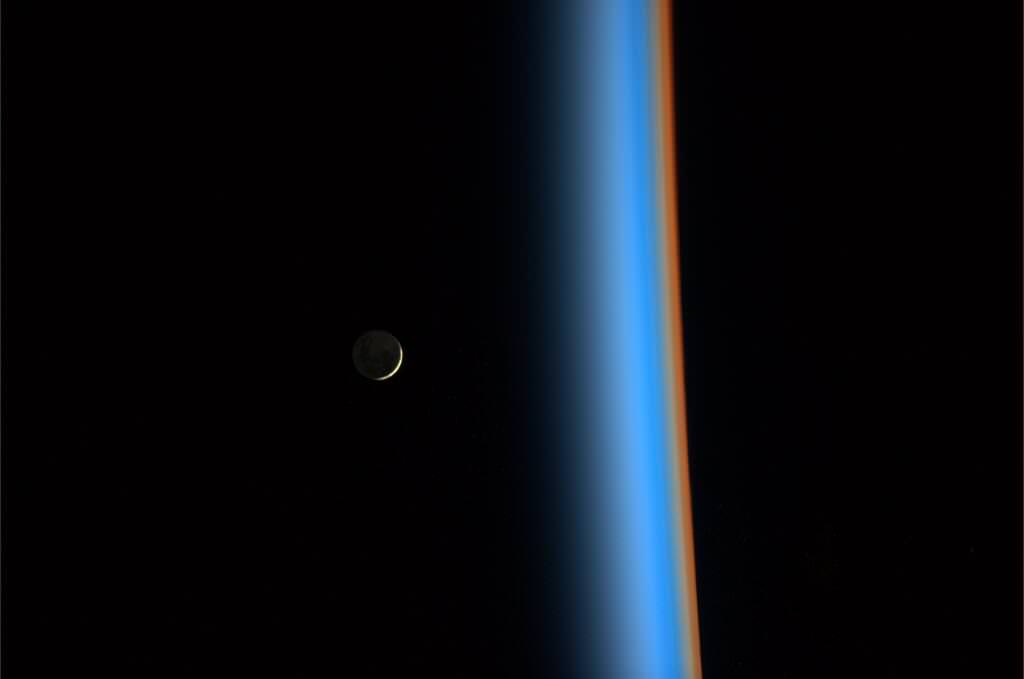
A crescent moon hovering above Earth’s delicate atmosphere. Green aurora flickering over Siberia. Space is a beautiful place, and we’re lucky right now to have an experienced photographer showing us the sights (or is that sites?) from the International Space Station.
In between preparing to be Japan’s first commander of the orbiting complex, JAXA Expedition 38 astronaut Koichi Wakata has tweeted at least one picture a day showing the view out the window and activities that he’s working on. It’s hard to pick favorites, but here are some of the best ones of the past week or so.
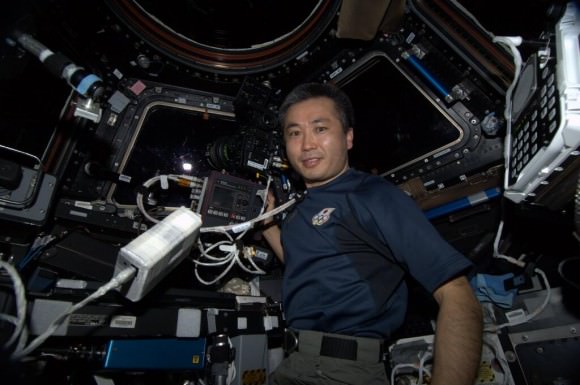

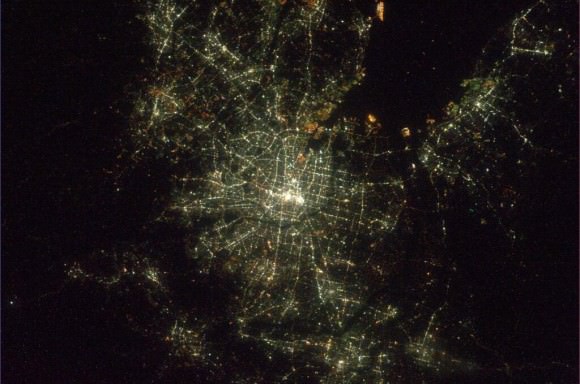
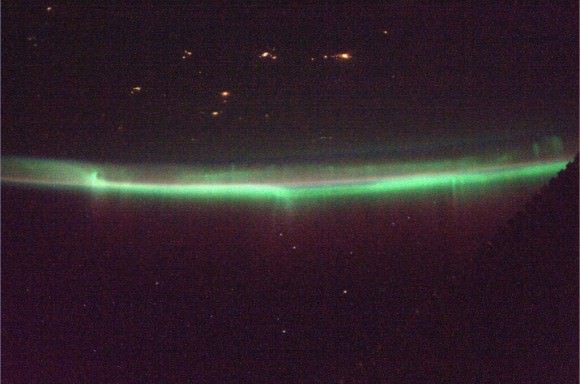

Fun New Kickstarter is a Space Station Detector
There’s a coffee shop in Pasadena, California that has a cool little device that lights up whenever the International Space Station is going to passover head, providing a little science lesson for patrons of the cafe. Called “ISS-Above,” the device is the brainchild of Liam Kennedy, a web designer, amateur astronomer and space enthusiast, and there’s a new Kickstarter for the project that will make the device available to anyone.
“It’s both an awareness thing, so more people get to know the Space Station is in their sky,” says Kennedy, “and it’s also to let those who are “up there” know that we know and appreciate what they are doing!”
That’s because not only does it light up when the ISS is nearby, it can also Tweet a message to the Space Station. Plus it has its own built-in web server to give you a ton of information about current and future passes.
It runs on a Raspberry Pi system with a memory card that can be loaded with your location information, so if you are a computer geek, this is totally up your alley! LEDs light up to alert you to the space station’s presence. There are different case options depending on how you’d like your own personal ISS-Above to look, including some colorful 3D-printed options.
But aren’t there already apps available that do this?
“True,” said Kennedy, “and I probably have almost all of them,” talking about the apps that will tell you when the ISS is going to be passing by. ”
“Those are great – BUT – that’s not what ISS-Above is about,” Kennedy said. “I wanted something small; a physical device that can just sit on a window sill or on a shelf beside the TV and light up every time the ISS is making a pass in my sky. Having these in my house for the past few months really has me understand the difference it makes to see just how frequently it passes nearby.”
For this Kickstarter, there are reward options that contain a complete ISS-Above and one of two types of colorful LED display devices, the PiGlow or the Ledborg. The PiGlow is unique with it’s circular/spiral layout while the Ledborg is intensely bright.
A complete ISS-Above device preloaded with your location is available for kicking in to the Kickstarter for $115. If you just want the memory card with your location and custom Twitter login for sending a Tweet to the ISS, then the price is just $42. There are several other options as well. The project has until February 27 to meet its funding goal of $5,000.
The device got its start when Kennedy decided to build his grandkids a device that would alert them when the ISS was going over their own backyards. He brought a sample of ISS-Above to the San Diego Mini Maker’s Faire and people went absolutely crazy for the device. (here’s their writeup about it) Then ISS-Above got noticed by Hackaday and Reddit
You can see many of the Tweets from people who already have the device at the @ISSAboveYOU Twitter feed.
Why a Kickstarter? Kennedy said that while the hardware for the device can be assembled by anyone, he still has many people who have asked him to provide a complete package already setup for their location. But he can only do that if there is enough volume. “Volume means I can purchase the components with lower shipping costs and more efficiently configure and assemble complete units,” he said.
His ultimate goal is to have ISS-Above devices in all space/science museums and public observatories around the world, and for that he needs to develop public display versions of ISS-Above utilizing more extensive LED/graphics capabilities. But again, he needs support to make that possible.
You can read more about the ISS-Above Kickstarter and the pledge rewards here.

Holy Wheels, Sharp Rocks Force NASA’s Curiosity rover to Seek Smoother Pathway to Mount Sharp

Up close photomosaic view shows lengthy tear in rover Curiosity’s left front wheel caused by recent driving over sharp edged Martian rocks on the months long trek to Mount Sharp. The team is evaluating an alternate, smoother way forward to next science target. Raw images taken by the MAHLI camera on Curiosity’s arm on Jan. 31, 2014 (Sol 529) were assembled to show some recent damage to several of its six wheels.
Credit: NASA / JPL / MSSS / Marco Di Lorenzo / Ken Kremer- kenkremer.com
See below complete 6 wheel mosaic and ‘Dingo Gap’ dune alternate route mosaic plus 3-D view[/caption]
Continuing wheel damage from hoards of sharp edged Martian rocks are forcing engineers to seek a smoother pathway forward – potentially through a treacherous dune field – for NASA’s Curiosity rover on the jagged rock strewn road to Mount Sharp, her primary science destination.
Ever since rover engineers noticed holes and tears to the robots six aluminum wheels this past fall and winter 2013, the team has been photographing the wheels much more frequently and carefully assessing their condition. See our mosaics above and below.
Curiosity’s handlers are now considering diverting the SUV-sized robot to an alternate path crossing into a dune field and the valley beyond that entails traversing through much smoother Martian terrain to reach a highly desirable and nearby science destination called “KMS-9.”
Newly received images taken by the robot only on Friday, Jan. 31, reveal a very significant ragged looking puncture at least 2 to 3 inches (5 to 8 cm) in length and a inch or so (3 cm) wide that’s bent back to the inside of the left front wheel.
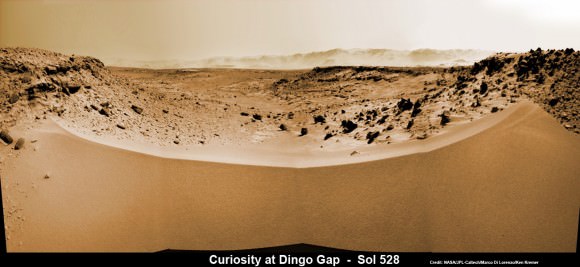
This photomosaic from Curiosity’s Navigation Camera (Navcam) taken at the edge of the entrance to the Dingo Gap shows a 3 foot (1 meter) tall dune and valley terrain beyond to the west, all dramatically back dropped by eroded rim of Gale Crater. View from the rover’s current position on Sol 528 (Jan. 30, 2014). The rover team may decide soon whether Curiosity will bridge the dune gap as a smoother path to next science destination. Credit: NASA/JPL-Caltech/Marco Di Lorenzo/Ken Kremer- kenkremer.com
See NASA’s 3-D view of Dingo Gap below
Unfortunately, the fields of rough Red Planet rocks have not been a blessing to the 1 ton behemoth.
See our new underbelly mosaic view of Curiosity’s holy wheels (above and below) snapped on Jan. 31, (Sol 529), that’s aimed at the interior and which vividly shows the extent of the injury to the 20 inch diameter wheel.

The rate of wheel damage has picked up dramatically as the driving pace accelerated across the rugged, rock filled Martian terrain over the past six months and put over 4.89 kilometers (3.04 mi.) on the odometer to date since the nailbiting August 2012 landing.
The mega robot is now standing at the edge of the dune field by the picturesque entrance known as the “Dingo Gap” after driving another 865 feet (264.7 meters) during January 2014.
You can see the increased damage resulting from the past months drive by comparing the new Sol 529 view with our underbelly mosaic from Sol 490 in December 2013.
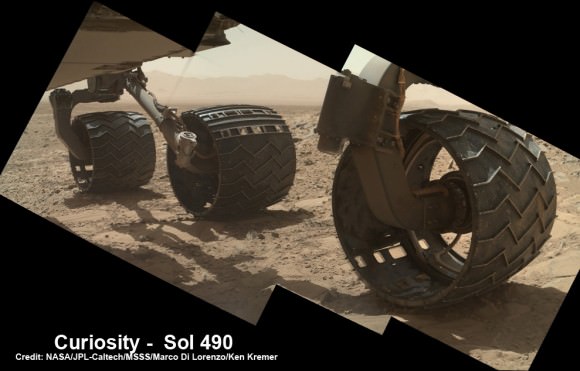
However, the dune cutting across “Dingo Gap” measures about 3 feet (1 meter) in height.
Look at this 3-D “Dingo Gap” mosaic view from NASA and you can judge for yourself the choices the team faces.
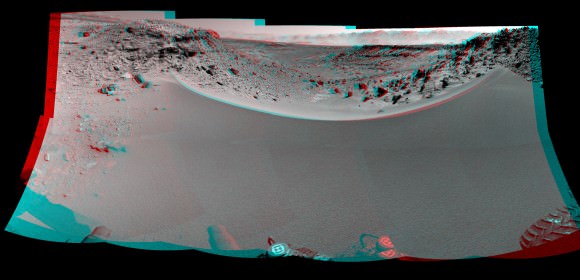
This stereo mosaic of images from the Navigation Camera (Navcam) on Curiosity shows the terrain to the west from the rover’s position on Sol 528 (Jan. 30, 2014). The scene appears three dimensional when viewed through red-blue glasses with the red lens on the left. The view was taken just after Curiosity had arrived at the eastern edge of a location called “Dingo Gap.” A dune across the gap is about 3 feet (1 meter) high in the middle and tapered at south (left) and north (right) ends onto low scarps on either side of the gap. The rover team is evaluating possible driving routes on the other side before a decision whether the cross the gap. Credit: NASA/JPL-Caltech
So the team is evaluating whether that’s safe to bridge because they don’t want to get stuck in a hidden sand trap like the one that ultimately led to Spirit’s demise a few years back.
“The decision hasn’t been made yet, but it is prudent to go check,” said Jim Erickson of NASA’s Jet Propulsion Laboratory, Pasadena, Calif., project manager for Curiosity, in a NASA statement.

“We’ll take a peek over the dune into the valley immediately to the west to see whether the terrain looks as good as the analysis of orbital images implies,” Erickson added, based on orbital images snapped by the High Resolution Imaging Science Experiment (HiRISE) camera on NASA’s Mars Reconnaissance Orbiter (MRO) circling overhead.
The team is also testing an array of different driving techniques to minimize the accumulation of wheel punctures, such as driving backwards or using only four of the six wheels to reduce the force of the wheels pushing against jagged rocks.
The “Dingo Gap” could offer a safer gateway to “KMS-9” along the journey of the rovers southwestwardly route to breathtaking foothills of Mount Sharp.

Dingo Gap lies between two low scarps and that is tapered off at both sides to the north and south.
KMS-9 is a potentially science rich target where the team hopes to conduct the first rock drilling operations since departing the Yellowknife Bay quadrant in July 2013.
The candidate drilling site lies only about half a mile (800 meters) away as the martian crow flies and features geology that’s appealing to the science team. But the roving routes under consideration are all much farther in actual distance.
“At KMS-9, we see three terrain types exposed and a relatively dust-free surface,” said science team collaborator Katie Stack of the California Institute of Technology, Pasadena.
Curiosity has already accomplished her primary goal of discovering a habitable zone on Mars that could support Martian microbes if they ever existed.
NASA’s rover Curiosity uncovered evidence that an ancient Martian lake had the right chemical ingredients, including clay minerals that could have sustained microbial life forms for long periods of time – and that these habitable conditions persisted on the Red Planet until a more recent epoch than previously thought.
As a result, the science team has shifted the missions focus to include the search for organic molecules – the building blocks of life as we know it – which may be preserved in the sedimentary rock layers of Mount Sharp.
“Really what we’re doing is turning the corner from a mission that is dedicated to the search for habitable environments to a mission that is now dedicated to the search for that subset of habitable environments which also preserves organic carbon,” Curiosity Principal Investigator John Grotzinger, of the California Institute of Technology in Pasadena, said recently at the Dec. 2013 annual meeting of the American Geophysical Union (AGU).
Meanwhile, NASA’s Opportunity rover is exploring clay mineral outcrops by the summit of Solander Point on the opposite side of the Mars at the start of her 2nd Decade investigating the Red Planets mysteries.
Read my new story about the Top 10 Decade 1 discoveries of Spirit and Opportunity – here.
And a pair of new orbiters are streaking to the Red Planet to fortify Earth’s invasion fleet- NASA’s MAVEN and India’s MOM.
Finally, China’s new Yutu moon rover is hibernating through her 2nd lunar night as we await word of her fate next weekend, around Feb 8 or 9.
Stay tuned here for Ken’s continuing Curiosity, Opportunity, Chang’e-3, SpaceX, Orbital Sciences, LADEE, MAVEN, MOM and Mars news.
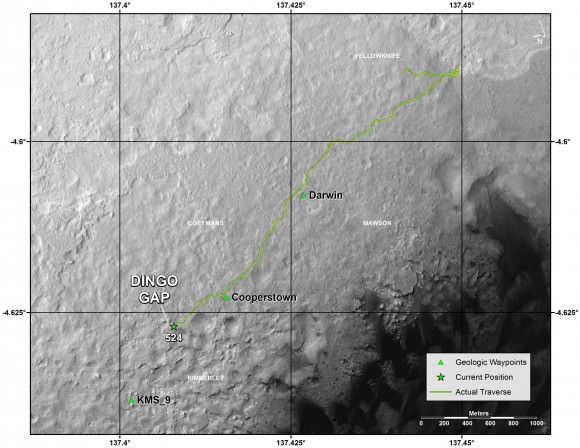
Credit: NASA/JPL-Caltech
Why Hawking is Wrong About Black Holes
A recent paper by Stephen Hawking has created quite a stir, even leading Nature News to declare there are no black holes. As I wrote in an earlier post, that isn’t quite what Hawking claimed. But it is now clear that Hawking’s claim about black holes is wrong because the paradox he tries to address isn’t a paradox after all.
It all comes down to what is known as the firewall paradox for black holes. The central feature of a black hole is its event horizon. The event horizon of a black hole is basically the point of no return when approaching a black hole. In Einstein’s theory of general relativity, the event horizon is where space and time are so warped by gravity that you can never escape. Cross the event horizon and you are forever trapped.
This one-way nature of an event horizon has long been a challenge to understanding gravitational physics. For example, a black hole event horizon would seem to violate the laws of thermodynamics. One of the principles of thermodynamics is that nothing should have a temperature of absolute zero. Even very cold things radiate a little heat, but if a black hole traps light then it doesn’t give off any heat. So a black hole would have a temperature of zero, which shouldn’t be possible.
Then in 1974 Stephen Hawking demonstrated that black holes do radiate light due to quantum mechanics. In quantum theory there are limits to what can be known about an object. For example, you cannot know an object’s exact energy. Because of this uncertainty, the energy of a system can fluctuate spontaneously, so long as its average remains constant. What Hawking demonstrated is that near the event horizon of a black hole pairs of particles can appear, where one particle becomes trapped within the event horizon (reducing the black holes mass slightly) while the other can escape as radiation (carrying away a bit of the black hole’s energy).
While Hawking radiation solved one problem with black holes, it created another problem known as the firewall paradox. When quantum particles appear in pairs, they are entangled, meaning that they are connected in a quantum way. If one particle is captured by the black hole, and the other escapes, then the entangled nature of the pair is broken. In quantum mechanics, we would say that the particle pair appears in a pure state, and the event horizon would seem to break that state.
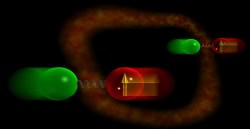
Last year it was shown that if Hawking radiation is in a pure state, then either it cannot radiate in the way required by thermodynamics, or it would create a firewall of high energy particles near the surface of the event horizon. This is often called the firewall paradox because according to general relativity if you happen to be near the event horizon of a black hole you shouldn’t notice anything unusual. The fundamental idea of general relativity (the principle of equivalence) requires that if you are freely falling toward near the event horizon there shouldn’t be a raging firewall of high energy particles. In his paper, Hawking proposed a solution to this paradox by proposing that black holes don’t have event horizons. Instead they have apparent horizons that don’t require a firewall to obey thermodynamics. Hence the declaration of “no more black holes” in the popular press.
But the firewall paradox only arises if Hawking radiation is in a pure state, and a paper last month by Sabine Hossenfelder shows that Hawking radiation is not in a pure state. In her paper, Hossenfelder shows that instead of being due to a pair of entangled particles, Hawking radiation is due to two pairs of entangled particles. One entangled pair gets trapped by the black hole, while the other entangled pair escapes. The process is similar to Hawking’s original proposal, but the Hawking particles are not in a pure state.
So there’s no paradox. Black holes can radiate in a way that agrees with thermodynamics, and the region near the event horizon doesn’t have a firewall, just as general relativity requires. So Hawking’s proposal is a solution to a problem that doesn’t exist.
What I’ve presented here is a very rough overview of the situation. I’ve glossed over some of the more subtle aspects. For a more detailed (and remarkably clear) overview check out Ethan Seigel’s post on his blog Starts With a Bang! Also check out the post on Sabine Hossenfelder’s blog, Back Reaction, where she talks about the issue herself.

